Rose-Breasted Grosbeak
Pheucticus ludovicianus
This bird is also called cut-throat because the male looks like his throat has been cut and has bled over his breast.
Advertisement
Rose-Breasted Grosbeak Scientific Classification
- Kingdom
- Animalia
- Phylum
- Chordata
- Class
- Aves
- Order
- Passeriformes
- Family
- Carinalidae
- Genus
- Pheucticus
- Scientific Name
- Pheucticus ludovicianus
Read our Complete Guide to Classification of Animals.
Rose-Breasted Grosbeak Conservation Status
Rose-Breasted Grosbeak Facts
- Prey
- Insects
- Fun Fact
- This bird is also called cut-throat because the male looks like his throat has been cut and has bled over his breast.
- Estimated Population Size
- 4.1 million
- Biggest Threat
- Predators, collisions
- Most Distinctive Feature
- The male’s red breast
- Other Name(s)
- Cut-throat
- Wingspan
- 11-13 in
- Incubation Period
- 11-14 days
- Litter Size
- 1-5
- Habitat
- Woods, swamps, near rivers, second growth forests, marshes, pastures, roadsides
- Diet
- Omnivore
- Type
- Bird
- Common Name
- Rose-breasted grosbeak
- Number Of Species
- 1
- Location
- North America, Central America, northern South America, the Caribbean
- Nesting Location
- Trees, vines, shrubs
- Age of Molting
- 10 days
- Migratory
- 1
View all of the Rose-Breasted Grosbeak images!
The rose-breasted grosbeak’s song is known for its sweetness. Males begin to sing in the morning and females sing while building their nests.
This bird is easy to identify because of its colors. It has a rosy breast, and the white bars on its wings are easily seen when it flies. Its big, conical beak is perfect for breaking the hard coverings of seeds. The beauty of its song is also memorable, and it has a contact call that sounds like “chink.” It prefers second-growth forests, which are the forests that return after the old-growth forests are cut down. The bird’s population is declining in some areas, and one reason may be that these second-growth forests are aging.
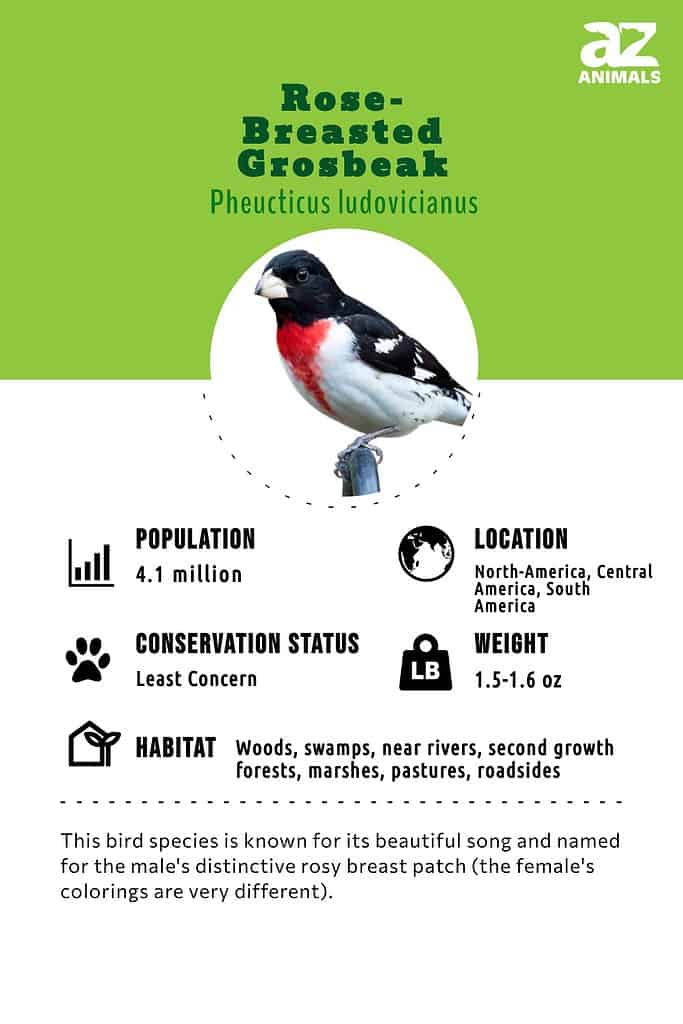
4 Amazing Rose-Breasted Grosbeak Facts!
- The female looks nothing at all like the male and looks like a large house sparrow.
- Though the species name means “shy,” rose-breasted grosbeaks won’t hesitate to see off much larger predators that are after their chicks.
- Rose-breasted grosbeaks sometimes hybridize with black-headed grosbeaks.
- They are very long-lived for such small birds. The oldest rose-breasted grosbeak in captivity lived for at least 24 years.
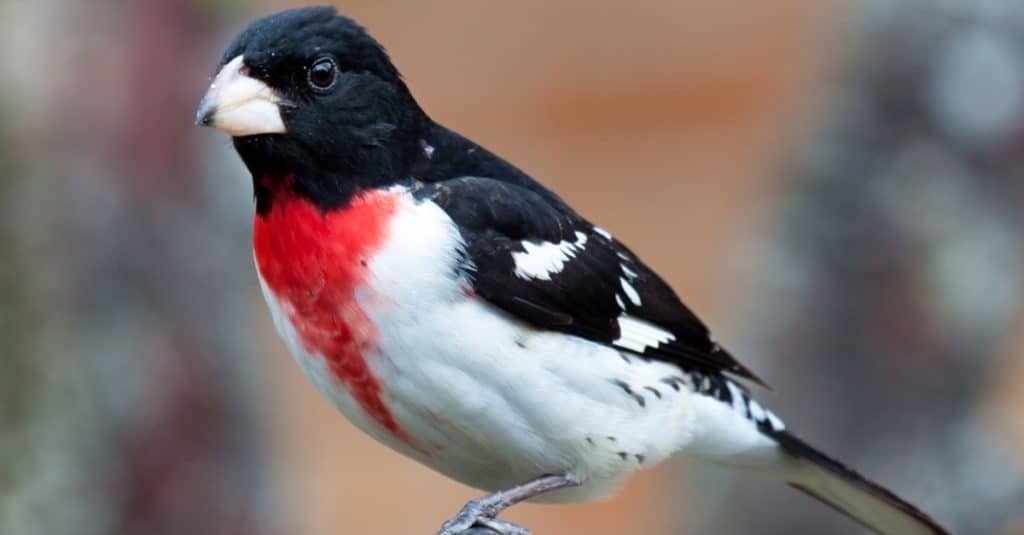
Rose-breasted grosbeaks are very long-lived for such small birds.
©Mike Truchon/Shutterstock.com
Scientific Name
The rose-breasted grosbeak’s scientific name is Pheucticus ludovicianus. Pheucticus comes from the ancient Greek for “shy” or “to flee,” and ludovicianus is New Latin for something from Louisiana. The bird was first described by a specimen that was collected by Mathurin Jacques Brisson in Louisiana. There are no subspecies of the rose-breasted grosbeak.
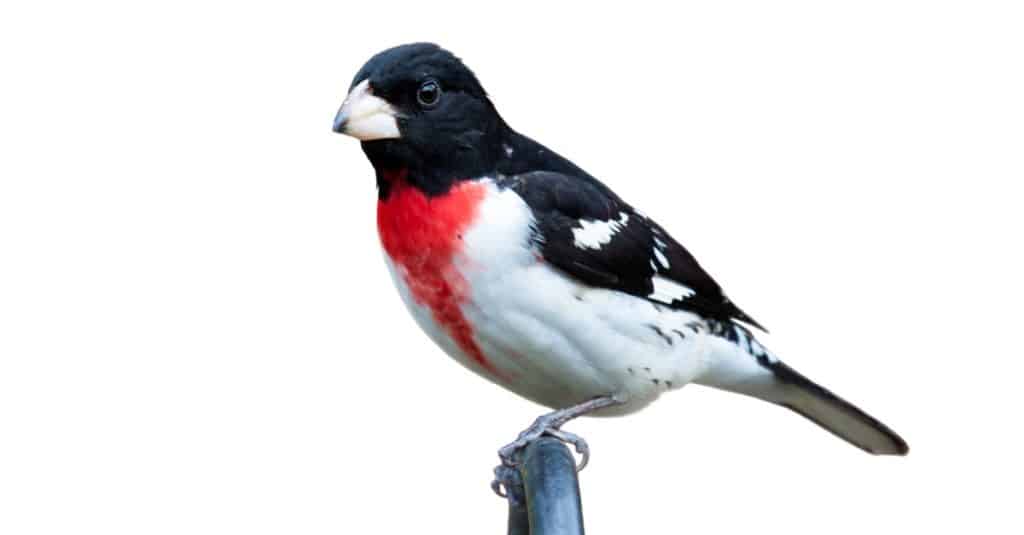
The rose-breasted grosbeak’s scientific name comes from ancient Greek for “shy” or “to flee.”
©Mike Truchon/Shutterstock.com
Evolution and Origins
The rose-breasted grosbeak belongs to the Pheucticus genus of grosbeaks and it is closely related to the cardinal, also a member of the Cardinalidae family of birds.
Scientists have made two unusual discoveries in the recent evolutionary history of the rose-breasted grosbeak.
A bilateral gynandromorph rose-breasted grosbeak — meaning it is half male and half female — was found and banded in 2020 at Powdermill Nature Reserve, located in Westmoreland County, Pennsylvania. The bird displayed the typical appearance of a male in its red wing pits, red breast spot, and black wing feathers on its right side, while on its left side it had female colorations of yellow wing pits and brown, speckled wing feathers. Gynandromorph birds are rare and scientists aren’t sure why they form, but some theories involve a developmental error occurring when an egg forms, chromosome loss, and “unreduced” sperm in fertilization.
The rose-breasted grosbeak is part of a new hybrid bird that was first discovered and documented in 2020 in western Pennsylvania. It is a first-generation naturally occurring bird that is a cross between a rose-breasted grosbeak and a scarlet tanager (Piranga olivacea). DNA analysis confirmed that the bird, which was given the nickname “tanabeak,” had a rose-breasted grosbeak as its mother and a scarlet tanager as its father. Although these species both belong to the Cardinalidae family, shared an ancestor more than 10 million years ago, and are found in the same habitats throughout eastern North America, they have not historically been known to crossbreed. The male rose-breasted grosbeak hybrid had notable differences in plumage such as a throat colored pink instead of black and in morphology, including a longer, shallower, and darker bill.
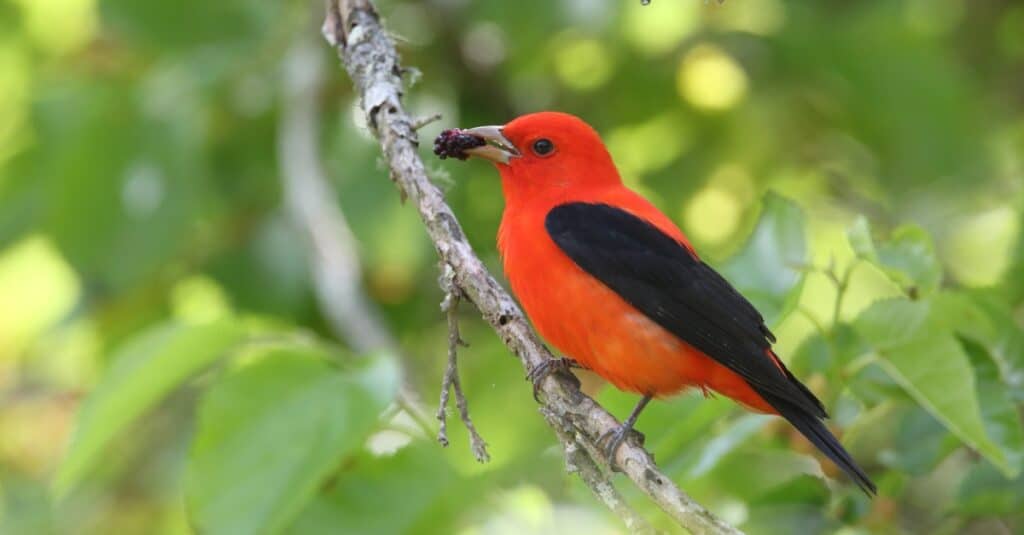
The first-ever hybrid between a scarlet tanager and a rose-breasted grosbeak was discovered in 2020.
©iStock.com/BrianLasenby
Appearance
When it comes to coloration, the sexual dimorphism of the rose-breasted grosbeak is dramatic. A male who is ready to breed has a distinctive rose-colored breast patch, black wings, and a black back, head, and tail. His rump and belly are white, and his wings have white patches and rosy linings. Males who aren’t in their breeding plumage are also white below but have white cheeks and a white streak over the top of the head called the supercilium. The feathers on his back and his wings are fringed in brown or white, and the primary flight feathers on his wings are also white. Another name for the bird is “cut-throat,” because the male looks like his throat has been cut, and he’s bled over his breast.
Female rose-breasted grosbeaks are dark brownish-gray on top, have a white supercilium and buff-colored stripe on the tops of their head, and underparts streaked with black. They have two white patches on the upper wings, and the linings of the wings are yellow. Both males and females have robust, horn-colored bills and black eyes and feet. Juvenile males look like females.
This grosbeak species is between 7 and 9 inches long, has a wingspan of between 11 and 13 inches, and weighs between 1.2 and 2.3 ounces on average. Females may be just slightly smaller than males.
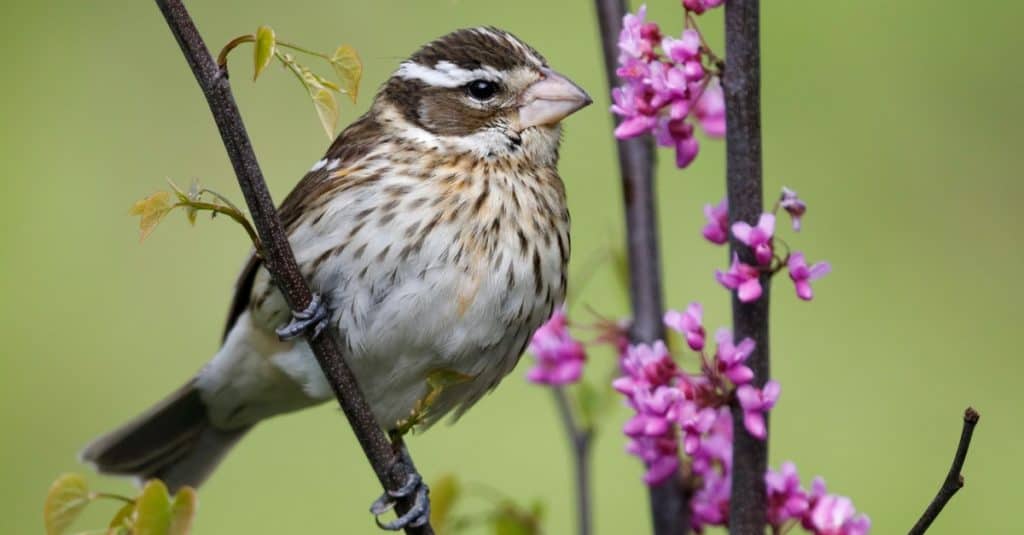
Female rose-breasted grosbeaks have very different colorings to males.
©Brian Lasenby/Shutterstock.com
Behavior
Rose-breasted grosbeaks are strong flyers and can be told by their dipping flight pattern as well as their colors, but on the ground, they hop. They are somewhat pugnacious and will chase away other birds, including birds as large as hawks or grackles. Most rose-breasted grosbeaks aren’t fooled when cowbirds lay their eggs in their nest and will kick the foreign egg out. Males are sometimes aggressive toward females until they realize she’s of the same species, and it’s the mating season. The bird moves among the trees and shrubs or searches on the ground to find food. It also grabs insects on the wing or hovers to catch them. It’s also a migratory bird.
The birds breed in the northern part of their range, which would be northern Canada as far west as British Columbia and as far south as northern Georgia. They can leave for their wintering grounds as early as late summer. These wintering grounds include Central America, Cuba, Hispaniola, and the northern reaches of Venezuela and Colombia. Stragglers may not return to the breeding grounds till the middle of May. Birds tend to come back to the same breeding grounds every year. Rarely, a rose-breasted grosbeak is seen in Europe.
Though rose-breasted grosbeaks are territorial when they’re nesting, they sometimes gather in groups to forage in their wintering grounds.
The rose-breasted grosbeak’s song is known for its sweetness. Juvenile males begin to sing when they’re about a month old. Males begin to sing early in the morning, and females sing while they build their nests. The contact call reminds some people of the call of a woodpecker. Other calls include chucks, squawks, and burrs.
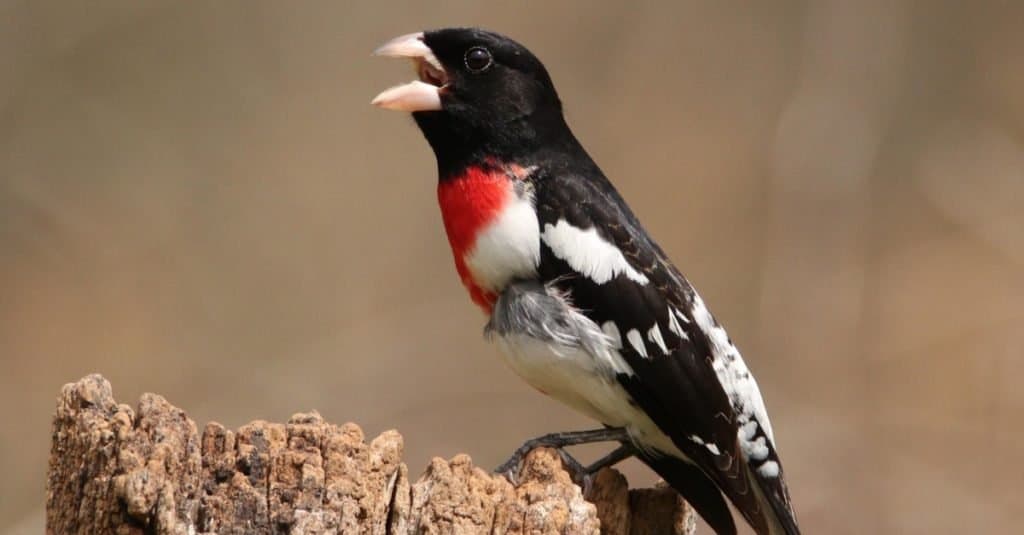
Juvenile males of this species start to sing when they’re around a month old.
©Mark W. Holdren/Shutterstock.com
Habitat
The rose-breasted grosbeak breeds in North America and winters in Central America, South America, and the Caribbean. It can be found in forests, by rivers, in marshes and swamps along the edge of the woods, and especially in second-growth forests. The habitats of its breeding and wintering ranges are similar.
The nest of the rose-breasted grosbeak is built in trees, sturdy vines such as Virginia creeper, or shrubs. It is cup-shaped and made of grass and twigs and lined with finer grass, pine needles, hair, or shredded bark. They are usually from 2.6 to 55 feet from the ground, and sometimes so loosely constructed that the eggs can be seen through the bottom.
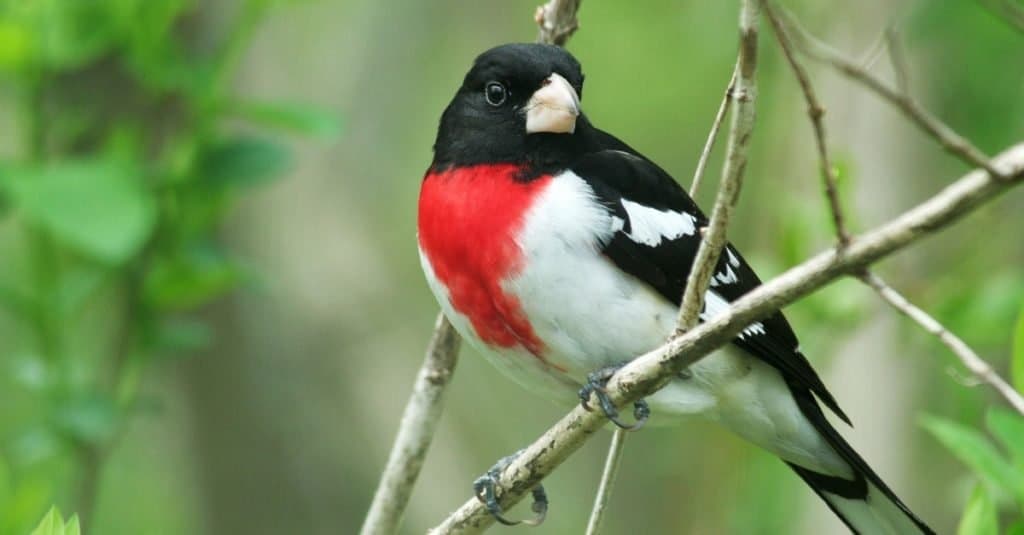
The rose-breasted grosbeak can be found in forests, particularly second-growth forests.
©Jayne Gulbrand/Shutterstock.com
Diet
The bird eats a wide variety of insects and vegetation. When they’re raising chicks, most of their diet will be insects. Insects that rose-breasted grosbeaks prey upon are different types of beetles, bees, bugs, ants, and caterpillars. They also take snails and spiders.
When they’re migrating and in their winter range they eat fruit. The birds sometimes eat the fruit from around the seeds or use their strong beaks to take off the husks of seeds and only eat the germ. They’ll also eat flowers and buds from trees. In the winter range, they seek out seeds that are rich in oils. They eat mast and a lot of soft fruits including blackberries and raspberries, mulberries, and elderberries as well as the seeds of pigweed, milkweed, and sunflowers. They raid farms for peas, corn, and grains.
Foods that should not be given to rose-breasted grosbeaks include chocolate, which is toxic. Bread is useless nutritionally, and moldy bread can make them sick. Table scraps may also be harmful.
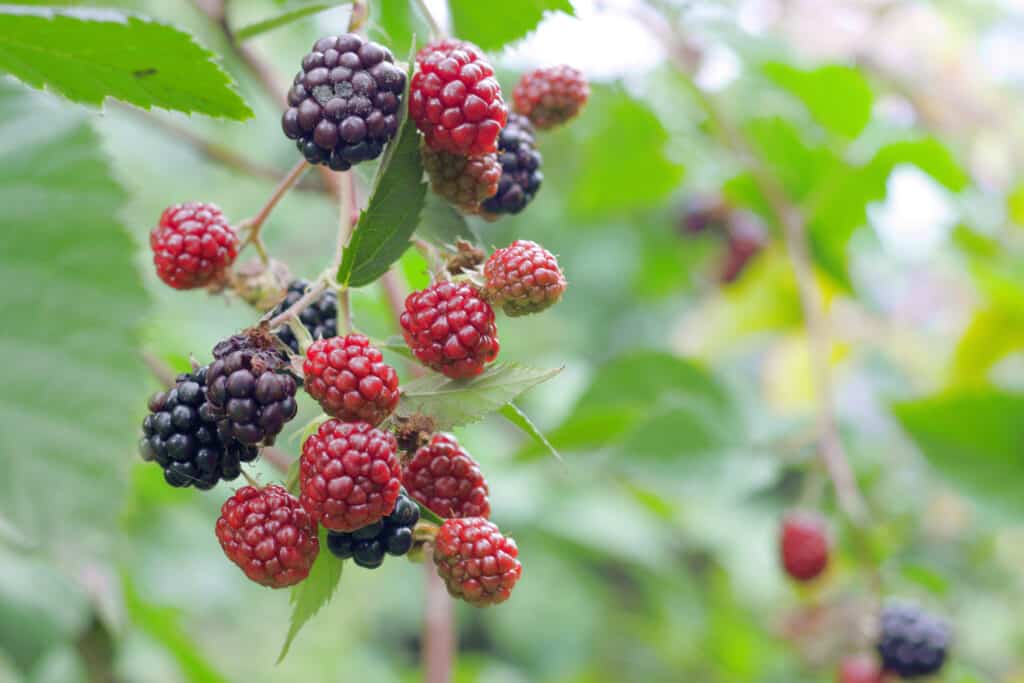
In the winter rose-breasted grosbeaks eat soft fruits such as wild blackberries.
©theLIMEs/Shutterstock.com
Predators and Threats
Predators that eat the birds, their chicks, or their eggs include squirrels, raccoons, grackles, blue jays, owls, and hawks. Other threats include colliding with cars and crashing into windows, being shot, or being caught by dogs or cats. Birds also die of diseases and bad weather, though reports on these causes of grosbeak mortality are scant.
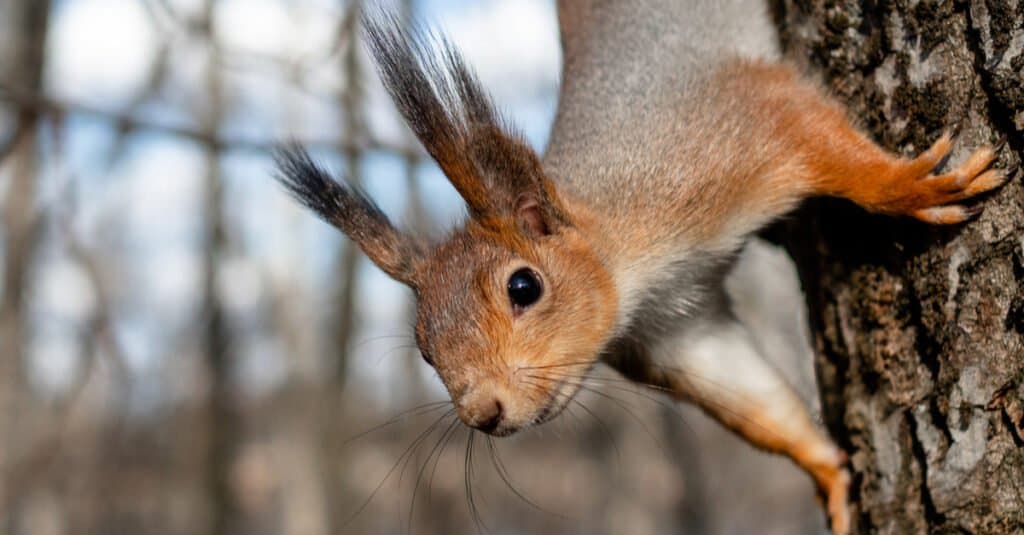
Squirrels are one of the main predators of these birds.
©Korobcorp/Shutterstock.com
Reproduction, Babies, and Lifespan
The breeding season is in spring when the birds come back from their winter range. Males stake out their territory and start to sing, which attracts the females. He may try to chase her away at first, then he performs a courtship display that includes fluffing up his feathers and a lovely, warbling song. If she accepts, they’ll pick out a place to build their nest.
After the nest is constructed, the female lays one to five eggs. They are blue-green and freckled with brown. Both parents sit on the eggs. They hatch all at once in about 10 days, and the chicks molt when they’re only 9 to 12 days old. They’ll be taken care of by both parents for another three weeks. The chicks will mostly be fed mashed-up insects and will stay with their parents until it’s time to fly south for the winter. The chicks will be able to reproduce themselves when they’re about a year old.
Rose-breasted grosbeaks are long-lived birds, and in the wild they can live to be 13.
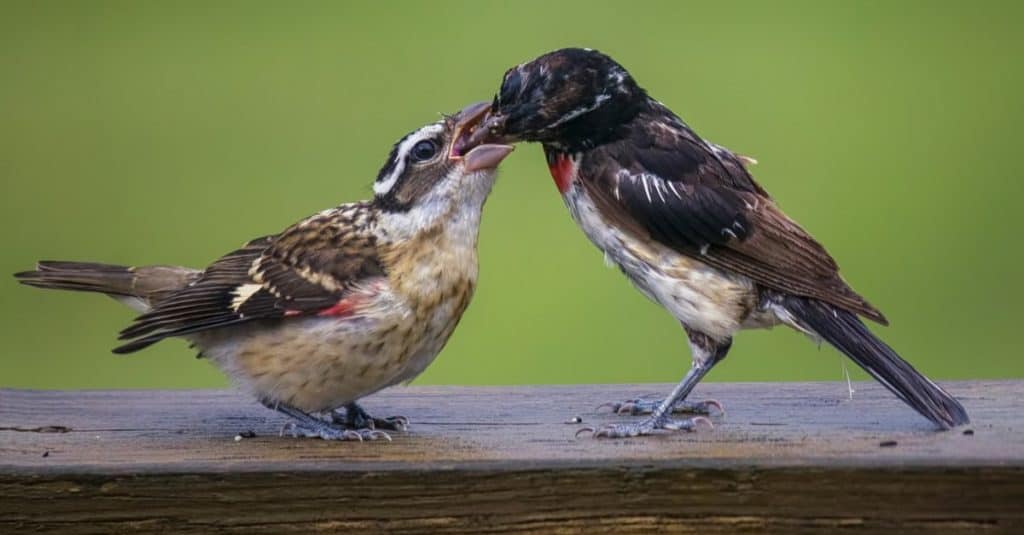
The rose-breasted grosbeak feeds its chicks mashed-up insects.
©Fiona M. Donnelly/Shutterstock.com
Population and Conservation
The population of the rose-breasted grosbeak is about 4.1 million, and the population appears to be stable with some decline here and there.
The IUCN Red List classifies this bird’s conservation status as Least Concern.

The IUCN’s Red List categorizes the rose-breasted grosbeak under Least Concern.
©Tobias Arhelger/Shutterstock.com
Rose-Breasted Grosbeak FAQs (Frequently Asked Questions)
Does the rose-breasted grosbeak migrate?
The rose-breasted grosbeak does migrate, sometimes from northern Canada to northern South America.
How many eggs does the rose-breasted grosbeak lay?
The bird lays between one and five eggs, with the average being four.
How fast does the rose-breasted grosbeak fly?
The rose-breasted grosbeak can probably fly about as fast as its cousin the cardinal, who can fly between 20 and 30 miles per hour.
What is the rose-breasted grosbeak’s wingspan?
The bird’s wingspan is between 11 and 13 inches.
When does the rose-breasted grosbeak leave the nest?
Rose-breasted grosbeak chicks leave the nest when they’re about 10 days old.
Are rose-breasted grosbeaks rare?
If you live in their breeding, migration, or winter ranges, rose-breasted grosbeaks are not rare at all and frequently come to bird feeders.
Where do rose-breasted grosbeaks live?
They live mostly in North America. In the United States, they’re found east of the prairie states and down into the Carolinas and northern Georgia during the breeding season. During winter migration, they fly down to Central America, Colombia, Venezuela, and some Caribbean islands.
How do you attract rose-breasted grosbeak?
Rose-breasted grosbeaks are attracted to hanging feeders and ground trays in the backyard. They savor seeds such as sunflower seeds and chips, cracked corn, suet, bits of raw peanut, safflower seeds, and fruits.
What does a female rose-breasted grosbeak look like?
The female sports colors that are rather drab compared to the cut-throat male. Her feathers are brown, white, and buff, and she has a brown cheek patch with a buff stripe over each eye. Juvenile males are similar.
Thank you for reading! Have some feedback for us? Contact the AZ Animals editorial team.
Sources
- Birds & Blooms / Accessed June 1, 2021
- Animal Diversity Web / Accessed June 1, 2021
- Datazone / Accessed June 1, 2021
- Wikipedia / Accessed June 1, 2021
- Audubon / Accessed June 1, 2021
- Humane Society / Accessed June 1, 2021


















